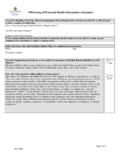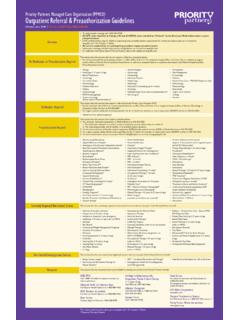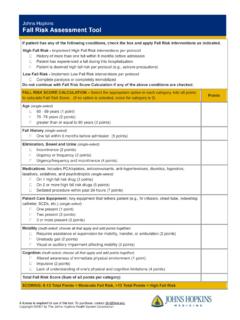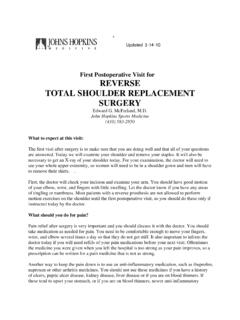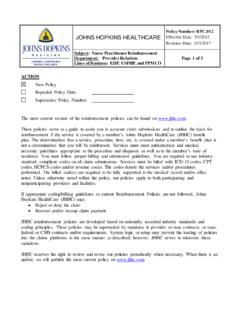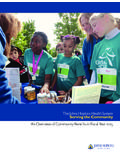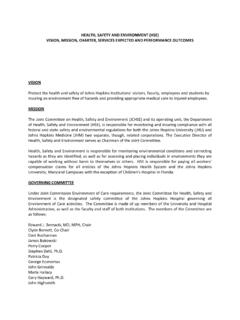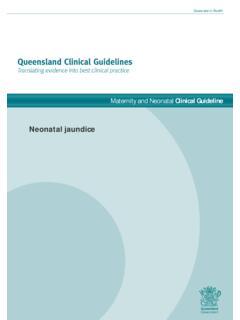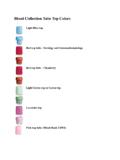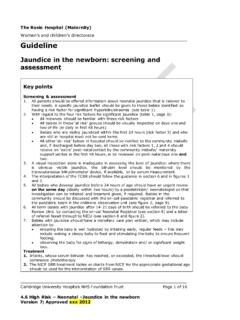Transcription of Anemia: Pathophysiology & Diagnostic Classification
1 Anemia: Pathophysiology & Diagnostic ClassificationLinda M. S. Resar, Professor of Medicine,Oncology & PediatricsKey ConceptsA.) Define anemiaB.) Describe the metabolic and physiologic responses to anemia, with emphasis on those that give rise to the clinical findings C.) Introduce the systemic Classification of anemia on the basis of morphology and red blood cell productionImportant Concepts from the Lecture:A.) The metabolic and physiologic changes that occur in response to anemia1.) Changes in cardiac output and perfusion of different organs ( , brain, skin, kidney and muscle)2.) How increased RBC mass affects oxygen delivery3.) How decreased oxygen affinity affects the ability to deliver oxygen to tissuesImportant Concepts from the Lecture (Continued):A.) Metabolic and physiologic responses to anemia(cont.)4.) How changes in blood volume and viscosity relate to oxygen transport ( , why a patient with a lower hematocrit may have more efficient oxygen transport and delivery than a patient with a higher hematocrit, but a smaller blood volume)5.
2 An understanding of the oxyhemoglobin dissociation curveB.) How to classify anemias on the basisof etiology and RBC parameters:1.) Decreased productionvs. RBC loss (increased destruction or bleeding)2.) RBC Size:Macrocytic vs. microcytic vs. normocytic3.) Hemoglobin Content:Hypochromic vs. normochromic4.) Shape: Normal or abnormalPart 1: The Metabolic and Physiologic Responses to AnemiaWhat is anemia?Anemia from the Greekword ( )(an-ha ma) meaning "without blood", is a deficiency of red blood cells(RBCs) and/or hemoglobin. Part 1: The Metabolic and Physiologic Responses to AnemiaWhat is anemia?The Complete Blood Count:1.) Hematocrit (Hct) or packed cell volume (PCV): Volume of packed red blood cells per unit of blood, expressed as a : 44 ml packed red blood cells/ 100 ml of blood= 44%2.) Hemoglobin = grams of hemoglobindL of bloodHematocrit (Hct) or packed cell volume (PCV): Volume of packed red blood cells per unit of blood, expressed as a students invent salad spinner centrifugeRice University undergraduates Lila Kerr and Lauren Theis turned an ordinary salad spinnerinto a device for diagnosing is anemia?
3 What is anemia?What is anemia?Who has anemia?Part 1: The Metabolic and Physiologic Responses to AnemiaOxygen Delivery:V02= x Q x Hb x (Sa02-Sv02)Oxygen carrying capacity: ml 02binds to 1 gm of HbQ = blood flow (ml/min)Hb = hemoglobin (gm/dL)Sa02= % saturation of arterial blood (100 mm Hg)Sv02= % saturation of venous blood (40 mm Hg)..1.) Increase in blood flow (or Q)2.) Increase in red cell mass (or Hb)3.) Increase oxygen unloading (Sa02-Sv02)To Increase Oxygen Delivery:V02= x Q x Hb x (Sa02-Sv02)..1.) Increase in blood flow (or Q)A.) Increased Cardiac OutputHg 7 gm/dLClinical Findings: HR, Pulse pressure,murmurs, bruits, hyper-dynamic precordium, tinnitis or roaring .1.) Increase in blood flow (or Q)B.) Changes in Tissue PerfusionOxygen Insensitive: skin (pallor), kidney Oxygen Sensitive (heart, brain, muscle)Clinical ) Increase in blood flow (or Q)2.) Increase in red cell mass (or Hb)3.) Increase oxygen unloading (Sa02-Sv02)To Increase Oxygen Delivery:V02= x Q x Hb x (Sa02-Sv02).
4 2.) Increase in red cell mass (or Hb)EPO (kidney) Reticulocytosis, immature RBCsClinically: Bony pain with expansion of the marrowExpanded marrow cavity: Hair on End appearanceErythropoiesis in bone marrowHyperviscosity: Red cell mass is too high!1.) Increase in blood flow (or Q)2.) Increase in red cell mass (or Hb)3.) Increase oxygen unloading (Sa02-Sv02)To Increase Oxygen Delivery:V02= x Q x Hb x (Sa02-Sv02)..3.) Increase oxygen unloading (Sa02-Sv02)A.) Decreased Oxygen Affinity2,3 - DPGG lycolysis: The source of 2,3 DPGHow & why does the RBC metabolize glucose:No mitochondria, therefore glycolysis = sole source for energy Anaerobic metabolism (90%):Glycolytic pathway(Embden-Myerhoff)Glucose Pyruvate& Lactate2, 3- DPG:1o RBC phosphategenerated via theRapoport-Luebering (2,3-DPG shunt) in the glycolyticpathwayAerobic metabolism (10%):Pentose Phosphate (Hexose Monophosphate)Shunt NADPHWhy?Generate energy (ATP) to maintain:- cell shape , flexibility- cation & H2O contentQ: A 20-year-old African-American man presents complaining of weakness, mild lower abdominal pain and a change in the color of his urine.
5 He noticed these symptoms abruptly this morning. Of note, he had been having some burning with urination for about the last week. He went to an urgent care center 2 days ago where he was prescribed trimethroprim-sulfamethoxazole for suspected prostatitis. He reports that "sickle cell" runs in his family. He also notes that he works at a fast food restaurant, where he eats two meals per day (usually hamburgers). He is afebrile. His blood work reveals a WBC of 10,000, hemoglobin of 9 g/dL, hematocrit of 28 %, MCV of 90 fl, and platelets of 200,000. His reticulocyte count is 12%. His LDH and indirect bilirubin are elevated. His haptoglobin is low at 5 mg/dl. His urine dipstick is positive for hemoglobin. His creatinine is testing is performed which reveals a negative direct antiglobulin test, a negative G6PD screen, and a hemoglobin electrophoresis that shows 59% HbA, 40% HbS, and 1% HbF. His peripheral smear shows: The condition most likely responsible for this patient's hemolytic process cell hemolytic hemolytic anemia1.
6 Increase in blood flow (or Q)2.) Increase in red cell mass (or Hb)3.) Increase oxygen unloading (Sa02-Sv02)To Increase Oxygen Delivery:V02= x Q x Hb x (Sa02-Sv02)..Oxyhemoglobin Dissociation Curve2 important properties:1.) Oxygen affinity (P50): Convenient index of oxygen affinity = Partial pressure of oxygen at which hemoglobin is 1/2 or 50% saturated. If the curve is shifted to the right, P50is increased and oxygen affinity is decreased (oxygenunloading is increase). Thus, P50varies inversely with oxygen ) Cooperativity: When hemoglobin is partially saturated with oxygen, the affinity of the remaining hemes in the tetramer for oxygen increase markedly. This phenomenon is explained by the existence of 2 Hb conformations: i.)Deoxy or T = tense formii.)Oxy or R = relaxed form(Bohr effect) oxygen temperature(Bohr effect) oxygen temperatureP50 = 26 mm HgOxyhemoglobin Dissociation Curve2 important properties:1.) Oxygen affinity (P50): Convenient index of oxygen affinity P50 = Partial pressure of oxygen whenthe hemoglobin is 50% saturated.
7 If the curve is shifted to the right, P50is increased and oxygen affinity is decreased. Thus, P50varies inversely with oxygen affinity.(Bohr effect) oxygen temperature(Bohr effect) oxygen temperatureP50 = 26 mm HgOxyhemoglobin Dissociation Curve2 important properties:2.) Cooperativity: When hemoglobin is partially saturated with oxygen, the affinity of the remaining hemes in the tetramer for oxygen increases significantly. This phenomenon is explained by the existence of 2 Hb conformations: i.)Deoxy or T = tense formii.)Oxy or R = relaxed form(Bohr effect) oxygen temperature(Bohr effect) oxygen temperatureP50 = 26 mm HgNO & HemoglobinCell Free Zone:Pressure/velocity gradients in laminar flow drive red cells to the center of the vessel, creating this cell free zone NO synthesis:Endothelial cells synthesize by smoothmuscle, activates guanylate cyclase vasodilationPart 2: Classification of AnemiaDiagnostic Approach To Anemia: General considerations1.
8 Is there decreased RBC production, increased loss (RBC destruction or RBC loss bleeding)?2.) Is the anemia Microcytic (small red blood cell size)?Macrocytic (large red blood cell size)?Normocytic (normal red blood cell size)?Part 2: Classification of AnemiaDiagnostic Approach To Anemia: General Considerations:3.) Is the anemia Hypochromic (decreased Hb per RBC)?Normochromic (normal Hb per RBC)?4.) Is the anemia associated withNormal RBC morphology?Abnormal RBC morphology?These questions can be answered using a few readily available clinical tests :1.) Is the patient anemic?Complete blood count (CBC), Hb, Hct2.) Is there decreased RBC production, increased RBC destruction, or RBC loss?Reticulocyte count3.) Is the anemia micro, macro, or normocytic?RBC Indices These questions can be answered using a few readily available clinical tests :4.) Is the anemia hypo or normochromic?RBC Indices5.) Is the RBC morphology normal or abnormal?
9 Peripheral blood smearThe Complete Blood Count:1.) Hematocrit (Hct) or packed cell volume (PCV): Volume of packed red blood cells per unit of blood, expressed as a : 44 ml packed red blood cells/ 100 ml of blood= 44%2.) Hemoglobin = grams of hemoglobindL of blood3.) Reticulocyte= Young RBCA nemia due to hemolysis or bleeding is characterized by the presence of a reticulocytosis. The reticulocyte count is used to assess the appropriateness of the bone marrow response to anemia. The normal reticulocyte count in a patient with a normal Hb and Hct is about 1%. Approximately 1% of circulating RBCs are removed daily and replaced by marrow young RBCs or reticulocytes (approximately 20 cc of RBCs /day).4.) Mean Cell (or Corpuscular) Volume (MCV):The MCV reflects the average size or volume of the RBC expressed in fl. MCV will tell you if the patient is micro, macro, or normocytic. MCV is calculated as follows:MCV = Hct= Volume of packed red cells (% X 10)RBC Count Red cell count (x 1012/l)5.
10 Mean Cell Hemoglobin (MCH):The MCH indicates the weightof Hb in the average red cell. MCH is calculated as follows:MCH = Hb= Hb (gm/dl X 10) RBC count Red cell count (x 1012/l)6.) Mean Cell Hemoglobin Concentration (MCHC):The MCHC indicates the concentration of Hb in the average red cell or the ratio of the weight of the Hb to the volume in which it is contained (chromicity), expressed in percent as follows:MCHC = Hb = Hb (gm/dl X 100) Hct Volume of packed red cells (ml per 100 ml)7.) Normal red blood cell morphology:is characterized by a donut shape with the center 1/3 of the red cell being pale or without hemoglobin. This is assessed on peripheral smear. Common Causes for Various Types of Anemia1.) Hypochromic, microcytic:Iron Deficiency Thalassemia syndromesSideroblastic anemiaTransferrin deficiency2.) Macrocytic:Megaloblastic Anemias (Folic acid/ B12deficiencies)Liver DiseaseReticulocytosisNormal newbornBone marrow failure syndromesDrugs (AZT, Trimethoprin sulfate)Common Causes for Various Types of Anemia (Continued):3.

